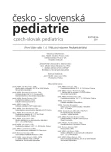Cena České pediatrické společnosti ČLS JEP
Vyšlo v časopise:
Čes-slov Pediat 2011; 66 (5): 348-349.
Kategorie:
Krátká sdělení
MUDr. Ondřej Hradský, Ph.D., z Pediatrické kliniky UK 2. LF a FN Motol Praha získal cenu České pediatrické společnosti ČLS JEP za původní práce uveřejněné v roce 2010, jejichž abstrakta publikujeme v tomto čísle.
1. Two Independent Genetic Factors Responsible for the Associations of the IBD5 Locus with Crohns Disease in the Czech Population
Ondrej Hradsky, MD, Petra Dusatkova, Mgr, Martin Lenicek, MD, Jiri Bronsky, MD, PhD, Dana Duricova, MD, Jiri Nevoral, MD, PhD, Libor Vitek, MD, PhD, Milan Lukas, MD, PhD, and Ondrej Cinek, MD, PhD
Inflamm Bowel Dis. 2010 Nov 8
[Epub ahead of print]
Backround: The role of the IBD5 locus in development of Crohn’s disease (CD) has not been clarified. In the Czech population we examined its genetic association using variants of the SLC22A4 (rs1050152), SLC22A5 (rs2631367), two single nucleotide polymorphisms (SNPs) shown to be associated with CD in genome-wide studies (rs6596075 and rs2188962), and four SNPs previously shown to tag the haplotype blocks 4, 7, 9, 10 of the IBD5 locus (IGR2063b_1, IGR2230a_1, IGR100Xa_1, IGR3236a_1).
Methods: The genotype, phenotype, and allelic frequencies were compared between 469 unrelated patients with CD (177 pediatric-onset, 292 adult-onset) and 470 unrelated healthy controls, all Caucasians of Czech ancestry.
Results: The most significant difference between patients and controls was found for the SNP rs6596075 (odds ratio [OR] = 0.70 for the G allele; 95% CI 0.52–0.94) in the dominant model and SNP IGR2063b_1 (OR = 1.38 for the G allele; 95% CI 1.14–1.67) in the log-additive model. We found a strong linkage disequilibrium across the IBD5 locus except rs6596075. The haplotype consisting of minor alleles of all tested SNPs except rs6596075 was carried by 31% patients and 23% control subjects (OR = 1.35, 95% CI 1.06–1.72). The association of variants in SLC22A4 and SLC22A5 was dependent on this risk haplotype, while the strong association of the rs6596075 was seemingly independent. In the analysis of subphenotypes we found only an association of the penetrating disease with rs6596075 (OR = 2.13; 95% CI 1.31–3.47).
Conclusions: Our study confirms the importance of IBD5 in determining CD susceptibility, and demonstrates that two independent genetic factors may be responsible for the association observed within this locus.
2. The CTLA4 variants may interact with the IL23R - and NOD2-conferred risk in development of Crohn’s disease.
Ondrej Hradsky, Petra Dusatkova, Martin Lenicek, Jiri Bronsky, Jiri Nevoral, Libor Vitek, Milan Lukas, Ivana Zeniskova and Ondrej Cinek
BMC Medical Genetics 2010, 11 : 91
Backround: The CTLA4 (cytotoxic T-lymphocyte antigen 4) gene is associated with several immunopathologic diseases and because of its important immuno-regulatory role it may be considered also a plausible candidate for a genetic association with inflammatory bowel diseases. Previously published studies found no association of CTLA4 with Crohn’s disease itself, but some indicated an association with its subphenotypes. The aim of this study was to assess the association in the Czech population, using a set of markers shown to associate with other diseases.
Methods: Six polymorphisms within the CTLA4 region were investigated in 333 patients with Crohn’s disease and 482 unrelated healthy controls, all Caucasians of Czech origin. The genotypes of the SNPs were determined using the TaqMan SNP genotyping assays. Haplotypes were reconstructed using an expectation-maximization algorithm, and their association with the condition was assessed using log-linear modeling. Then, potential interactions were tested between the CTLA4 variants and other genetic factors known to confer the disease susceptibility.
Results: No crude associations with Crohn’s disease were found for the tested CTLA4 variants under the log-additive or dominant models. However, when stratified for the genetic risk conferred by the variants in the NOD2 (the p.Leu1007fsX1008, rs5743293) or the IL23R (p.R381Q, rs11209026), a significant negative association emerged for the minor alleles of CTLA4 CT60 (rs3087243), JO31 (rs11571302), JO27-1 (rs11571297) polymorphisms. This negative association with CTLA4 was apparent only in the strata defined by presence minor alleles at the NOD2 rs5743293 (here the CTLA4 CT60 A coffered an OR = 0.43, 95% CI 0.19–0.95 for the presence of CT60 A), or IL23R rs11209026 (here the OR for presence of CT60 A was 0.23, 95% CI 0.07–0.71). We observed this effect also for the haplotype consisting of minor alleles of the three tightly linked CTLA4 markers. Furthermore, this haplotype was associated with the younger age at diagnosis (OR 1.52, 95% CI 1.09–2.11, p=0.014).
Conclusions: A protective effect of a CTLA4 haplotype was unmasked after stratification for the risk variants in the NOD2 and IL23R genes, and may point towards the biological relevance of the molecule in the pathogenesis of the disease.
Štítky
Neonatologie Pediatrie Praktické lékařství pro děti a dorostČlánek vyšel v časopise
Česko-slovenská pediatrie

2011 Číslo 5
- Isoprinosin je bezpečný a účinný v léčbě pacientů s akutní respirační virovou infekcí
- Horní limit denní dávky vitaminu D: Jaké množství je ještě bezpečné?
- Orální lichen planus v kostce: Jak v praxi na toto multifaktoriální onemocnění s různorodými symptomy?
Nejčtenější v tomto čísle
- Rehydratační léčba
- Tromboembolické príhody u novorodencov pohľadom dnešnej medicíny
- Vnitřní prostředí a patofyziologie tělesných tekutin
- Vplyv dýchania cez ústa na rastové zmeny splanchnokránia v detskom veku
